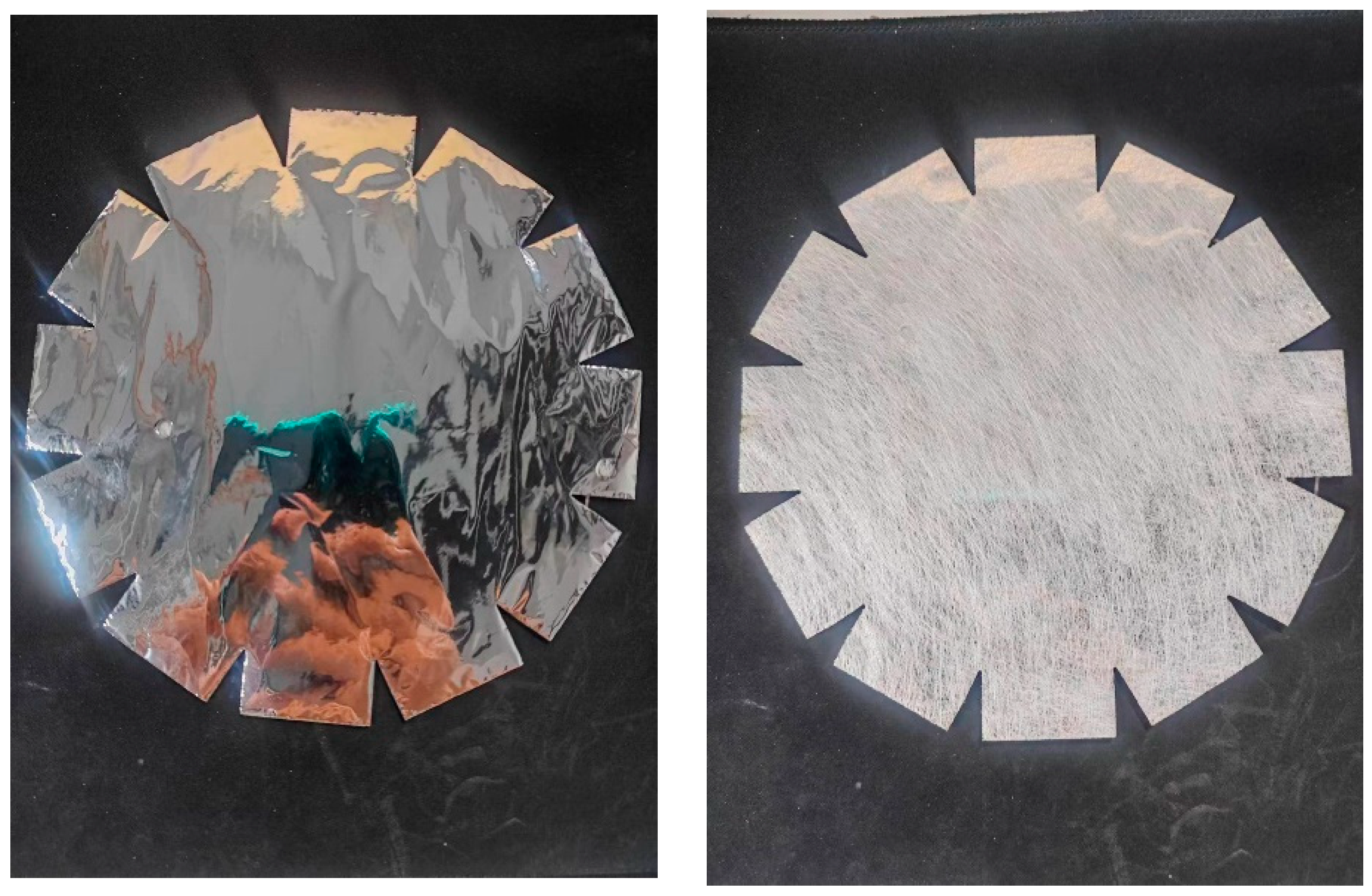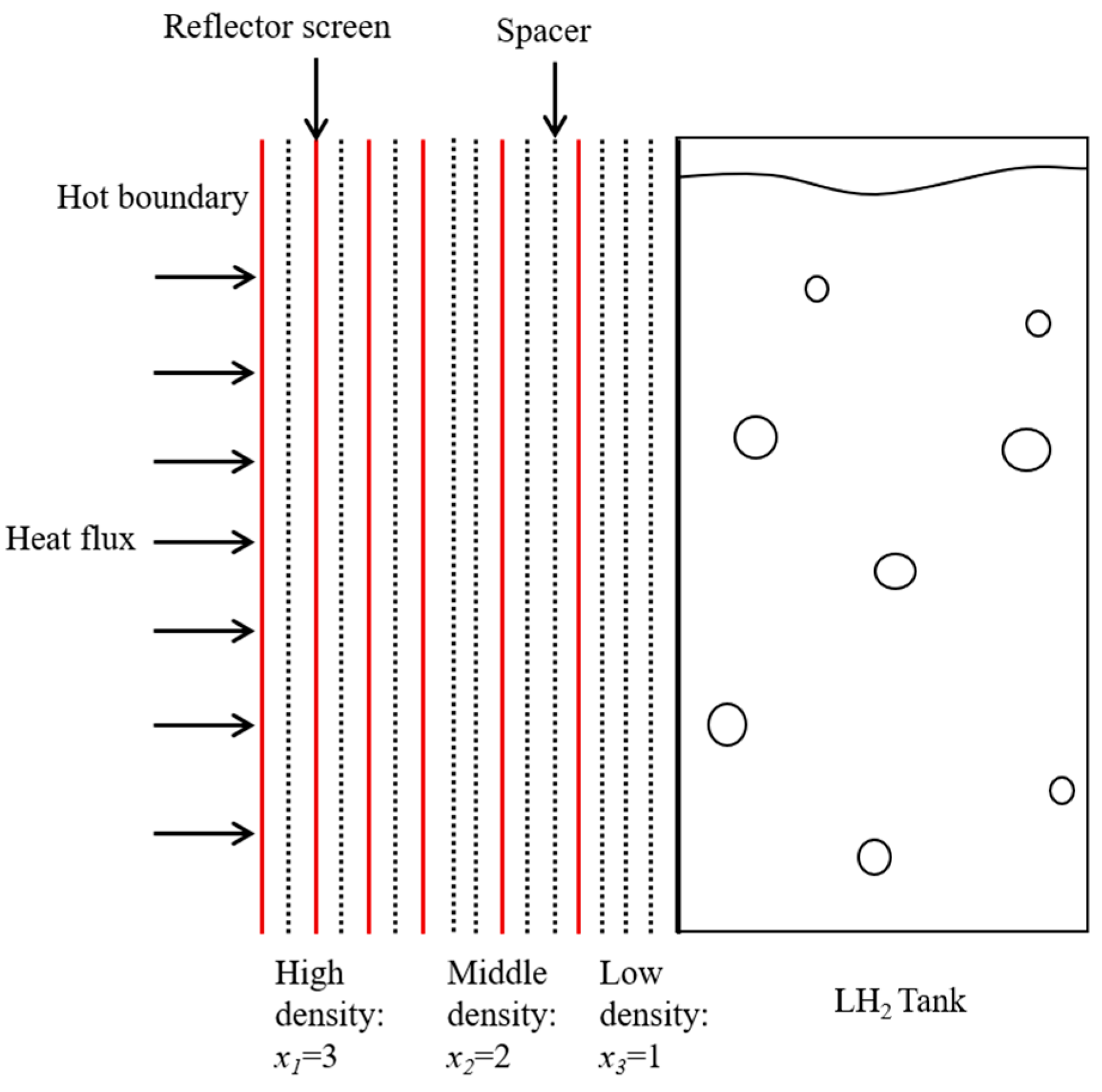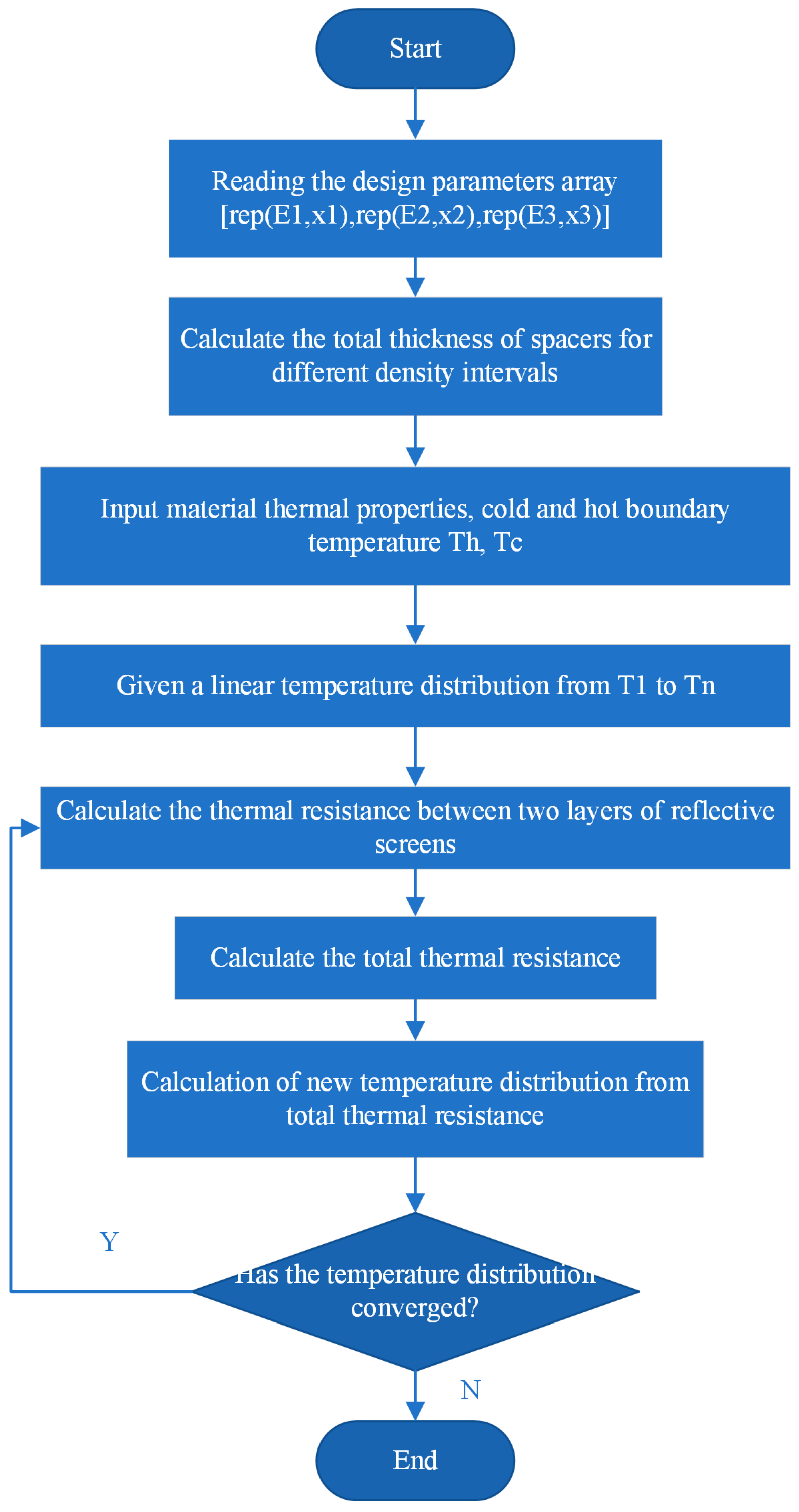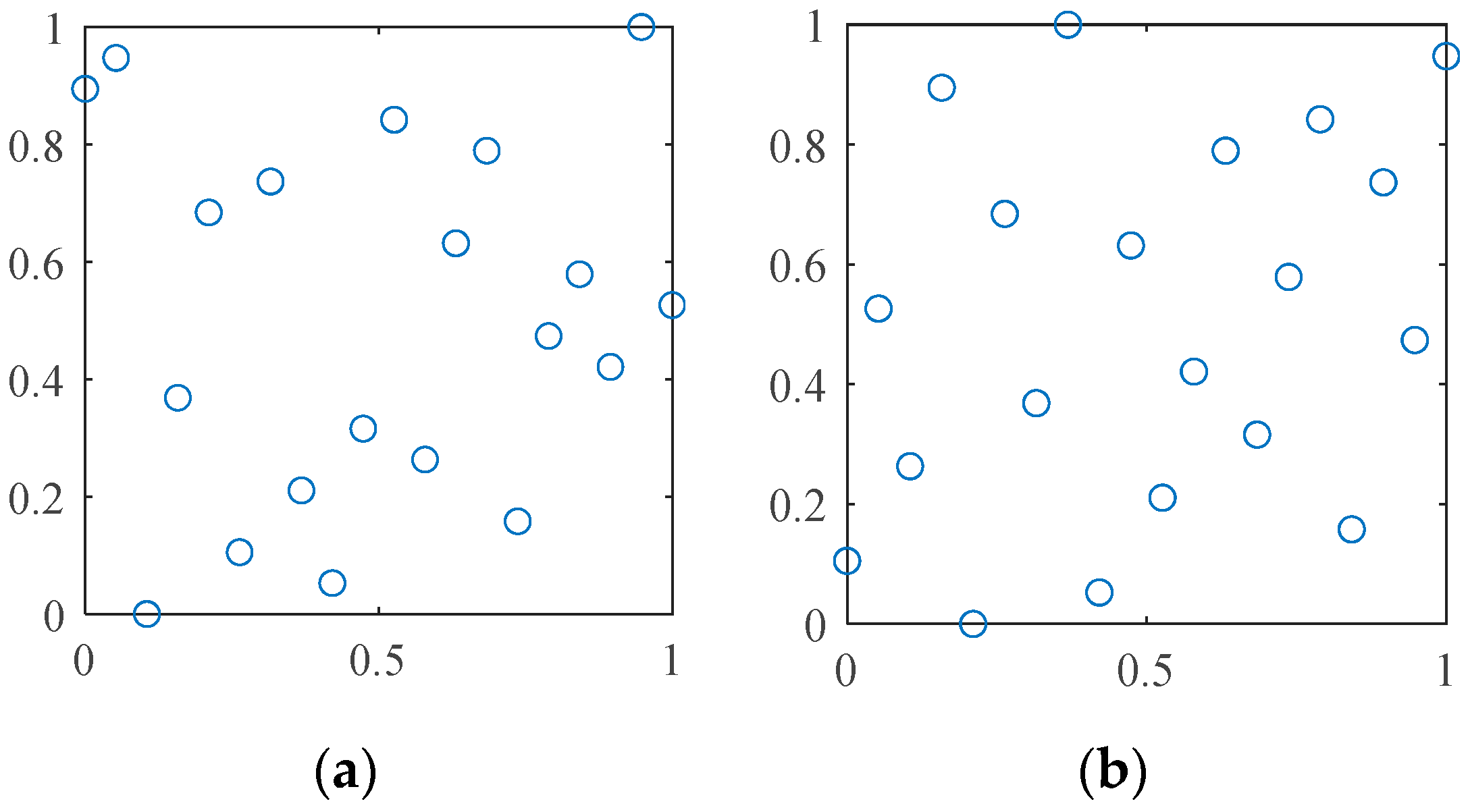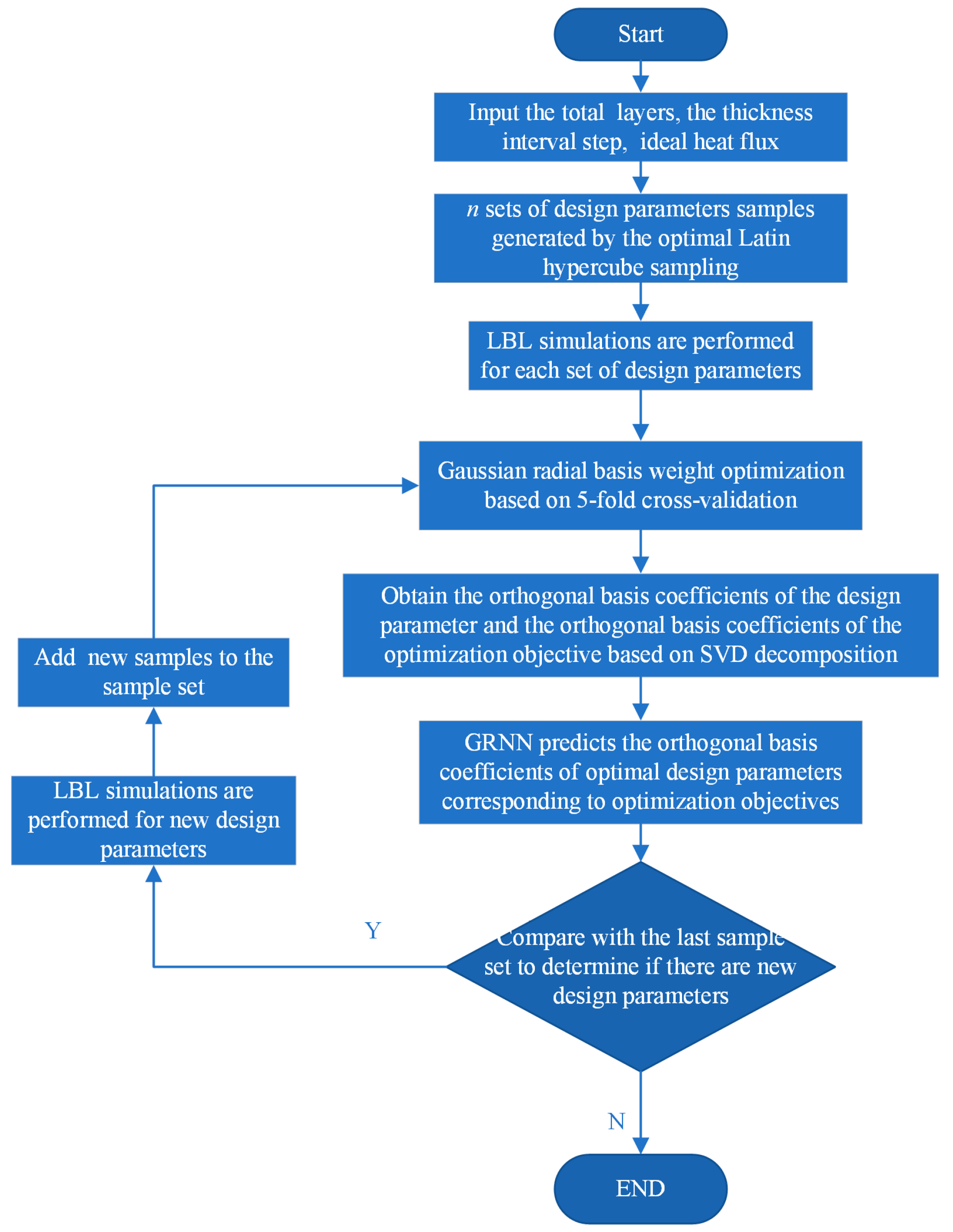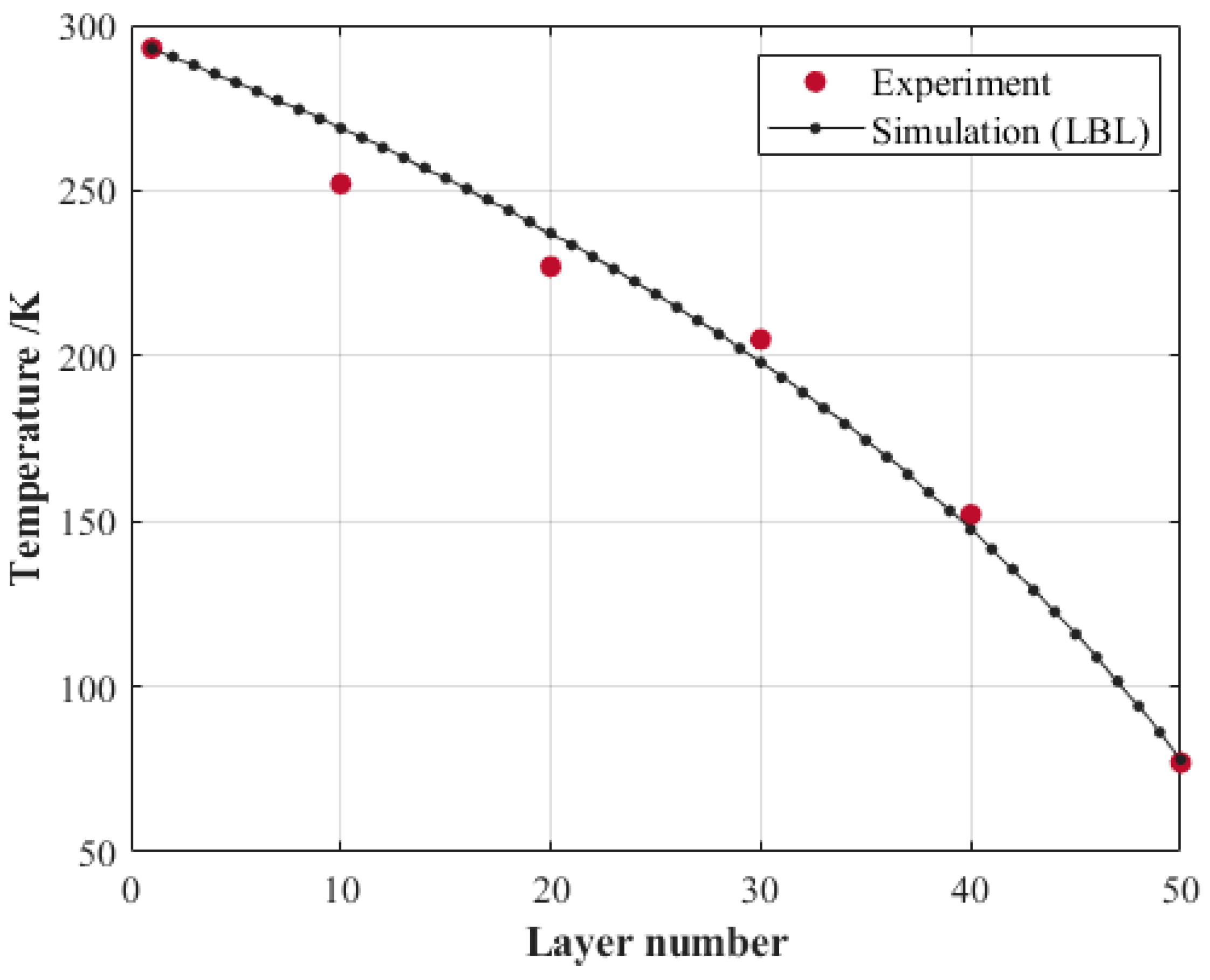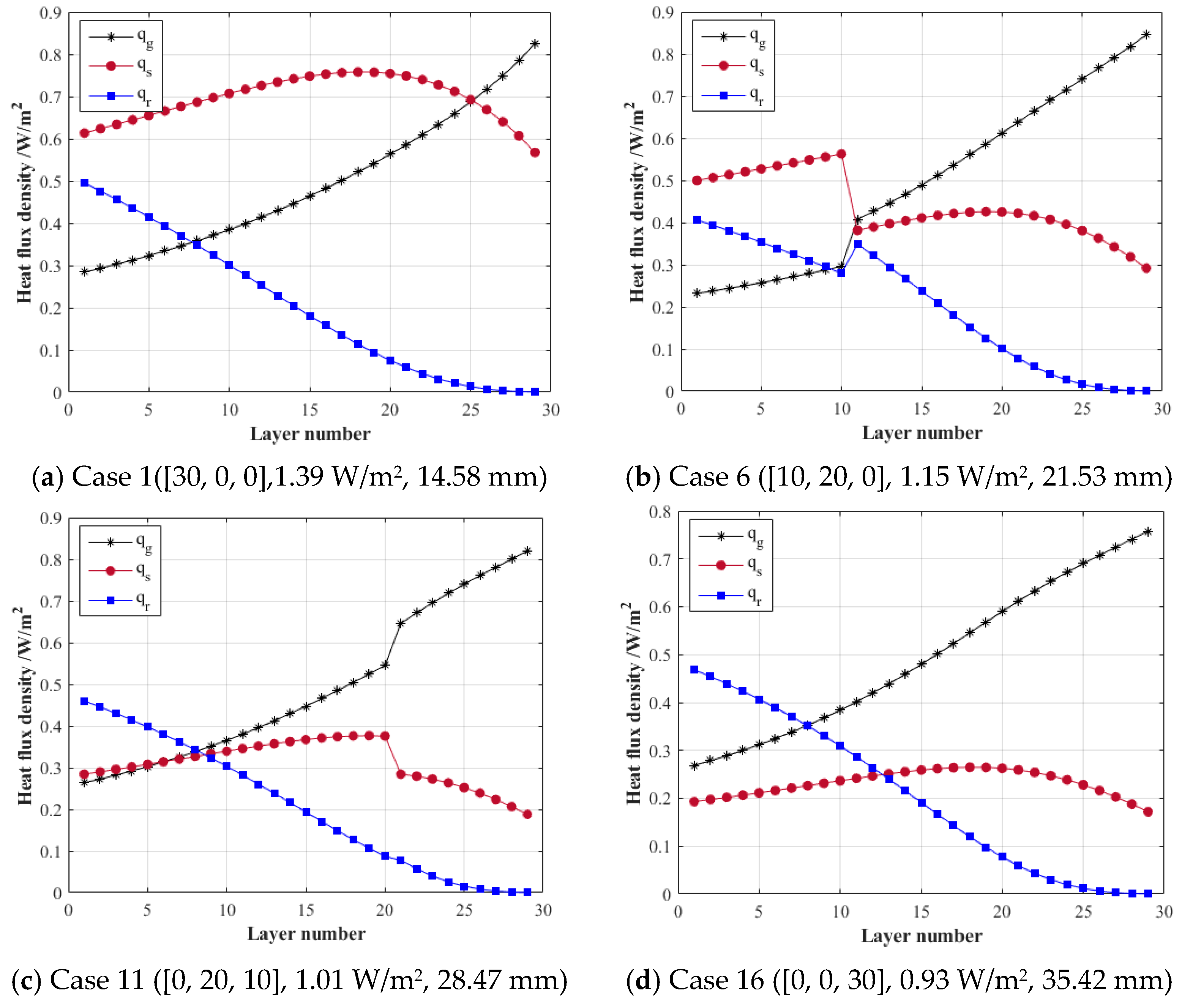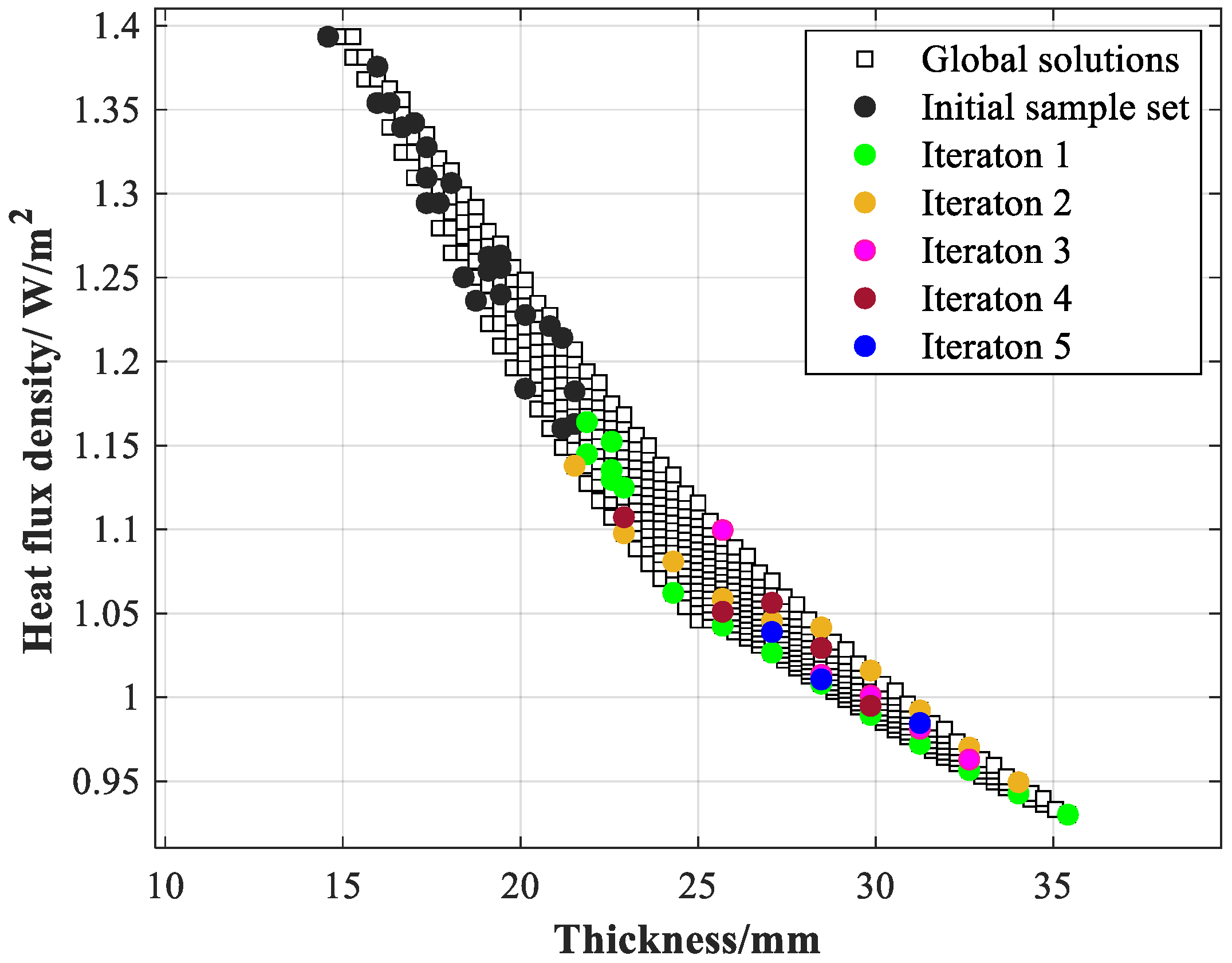1. Introduction
Liquid hydrogen (LH2) is usually stored and transported at 20 K under ambient pressure. The boil off of LH2 caused by heat leakage leads to a significant increase in the storage and transportation cost. Due to the excellent thermal insulation performance, variable density multi-layer insulation (VD-MLI) has been regarded as a basic insulation component for LH2 containers. There are different vehicles, such as cryogenic hydrogen–oxygen rockets, LH2 lorries, and LH2 cargo carriers, imposing stringent requirements on the space and weight of LH2 containers. We can easily understand that controlling the space and weight of a thermal insulation structure can improve the efficiency of LH2 transportation significantly. Therefore, the optimization of VD-MLI configurations has attracted more and more attention in the field of cryogenic engineering.
The existing VD-MLI optimization is mainly based on the Lockheed model [
1], which is a semi-empirical equation obtained by fitting experimental data at temperatures above 77 K. The Lockheed model can not be employed directly to optimize the MLI configuration at LH
2 temperature [
2]. On the other hand, the layer-by-layer (LBL) model was used to calculate the heat leakage in VD-MLI structures at LH
2 temperature [
3]. It is assumed that the heat transfer between each layer of MLI consists of three independent heat fluxes, and each layer temperature can be determined separately. Thus, it is possible to develop VD-MLI optimization methods based on the LBL model. The layer density is chosen as the design parameter of VD-MLI in engineering applications.
Hastings [
4] used the LBL model and modified Lockheed model to analyze the thermal insulation performance of a Foam/VD-MLI combination for orbital storage of LH
2. The results demonstrated that VD-MLI exhibits an ideal thermal insulation performance with a significant reduction in weight. Johnson [
5] compared several optimization models of VD-MLI based on the experimental results, and the Lockheed model, modified Lockheed model, NEW Q model and Mcintosh model were investigated. Wang [
6] proposed a VD-MLI optimization method by inserting a reflector at the optimal positions, and an experimental validation was conducted. All the above works focus on the single-objective optimization with layer density as the design parameter and the heat flux as the objective. The multi-objective optimization of VD-MLI has rarely been reported.
In order to further improve the performance of the thermal insulation materials, the composite insulation systems composed of VD-MLI and other auxiliary components have attracted more and more attention. A Vapor Cooled Shield (VCS) is used to offset the heat intrusion by utilizing cooing capacity of boil-off gas in LH
2 containers [
7], and the insulation performance of the VD-MLI-based LH
2 containers could be further improved [
8]. For example, Jiang [
9] developed a one-dimensional heat transfer model for the combination of Foam/VCS/VDMLI for orbital storage of LH
2, and the position of VCS was optimized. The results showed that the heat flux into the LH
2 tank is reduced by 59.6% when VCS is located at the optimal position as compared to the case without VCS. Huang [
10] investigated the thermal insulation performance of Foam-VDMLI and VD-MLI under conventional atmospheric conditions and vacuum conditions (10
−3 Pa), based on a liquid nitrogen boil-off calorimeter system. The results showed that the heat flux of Foam-VDMLI was only 30.58% compared to that of VD-MLI at atmospheric conditions. Shi [
11] investigated a composite thermal insulation system consisting of variable-density multi-layer insulation (VD-MLI) and vapor-cooled shields (VCS) integrated with para-ortho hydrogen (P-O) conversion, which has been proposed for long-term storage of liquid hydrogen. The effect of VCS on heat flux density is discussed, and the optimal placement of VCS and the ultimate performance that can be achieved when VCS is combined with VD-MLI is obtained. The result shows that compared to that without VCS, the heat leak with multiple VCSs can be reduced by max of 79.9%. Wang [
12] investigated the thermal insulation performance of Foam/Hollow Glass Microspheres (HGMs) combined with MLI/VD-MLI. The different heat fluxes in four insulation structures were analyzed, and the results showed that the thermal insulation performance of the MLI and VD-MLI systems were improved by 33% and 13%, respectively. Liu [
13] investigated the variation of Foam/MLI thermal insulation performances based on an LBL model at boundary temperatures from 55 K to 700 K, and boundary pressures from 10
−6 Pa to 10
5 Pa. The results indicated a complex variation of heat flux within Foam/MLI with different orbits of the spacecraft, but the variation of heat flux was not discussed when foam is combined with VD-MLI. Therefore, it is necessary to solve the optimal configuration of VD-MLI to enhance the thermal insulation performance. In addition, the existing VD-MLI optimization methods are mainly based on single-objective optimization, and it cannot be proven that the optimized configurations are globally optimal.
In Lockheed models, the layer density is implicitly related to the heat flux density. Some semi-empirical coefficients need to be corrected to improve the fitting accuracy. For example, Fesmirea [
14] used a calorimeter to test six VD-MLI configurations at the temperature range of 78–293 K and ambient pressure range of 10
−6 torr to 760 torr for 10–80 layers of MLI, and the coefficients of the Lockheed model were modified. A multi-dimensional parametric regression model can be employed to predict the performance of VD-MLI at the presence of multi-dimensional design parameters. Using a data dimensionality reduction method e.g., POD method [
15], the best low-rank approximation of original sample set can be obtained through data dimensionality reduction, and the prediction performance is also excellent in the case of small sample size by no-linear regression of the orthogonal basis coefficient.
In view of the user-friendly interface communication of complex solvers, surrogate model is suitable for a high computational cost-optimizing problem. Joakim [
16] present a novel SbNSGA-II ALM-surrogate-based NSGA-II. It is a robust and fast multi-objective optimization method based on kriging surrogate models and NSGA-II with Active Learning MacKay (ALM) design criteria. The SbNSGA-II ALM method is faster than the NSGA-II method, preserving the robustness and diversity of the Pareto front identified. Phiboon [
17] developed an RBF/Kriging hybrid multi-fidelity surrogate model. A non-dominated sorting genetic algorithm II is selected to solve the airfoil design problem. The objective of the optimization problem is to minimize the aerodynamic drag and maximize the lift force. The results showed that the UAV airfoil shape and the selected optimum airfoil shape had been successfully obtained with the algorithm. The error of the aerodynamic lift and drag is less than 10% in comparison with the wind tunnel experiment results.
In this study, a VD-MLI optimization method is proposed by defining the number of repetitions of basic units as the design parameter and employing the proper orthogonal decomposition with general regression neural network [
18] (POD-GRNN) as the surrogate model. A sample set of design parameters is generated by optimal Latin hypercube sampling, and the response parameters are obtained by solving the LBL equations. The sample set consists of the total thickness, number of layers, heat flux density, and design parameters of a VD-MLI. The optimal approximation of the low-rank distribution of the sample set is obtained by the POD, and the response parameters are obtained by regression of GRNN on design parameters and orthogonal basis coefficients. The generalization ability of the POD GRNN around the optimal solution is continuously improved by adding non-dominated solutions in the sample set. The optimization method theoretically proved the existence of a multi-objective optimal configuration for a VD-MLI.
2. Methodology
The VD-MLI can be implemented by stacking different layers of spacers, and the density of reflectors varies in different parts of the MLI. Due to the space limitation of the container, the total thickness and insulation performance of the VD-MLI can be set as optimization objectives. The reflector is made of aluminum foil and the spacer material is glass fiber. The emissivity of the reflector (
ε) is 7.39
10
−4 and the thermal conductivity of the spacer (
ks) is 8.823
10
−6 + 1.04
10
−7 W/m
K. The materials of this study are shown in
Figure 1.
As shown in
Figure 1, the reflector is used to reduce the radiation heat flux, and the spacer is made of porous material with low thermal conductivity to mitigate the heat leakage in the low temperature zone. The residual gas in MLIs can be evacuated from the porous structure. It is found that the residual gas pressure may be 10–50 times higher than the nominal vacuum pressure [
19,
20], and the interlayer pressure is variable at different layer positions. Thus, in order to improve the precision of the simulation model, the residual gas pressure is assumed as 5 × 10
−2 Pa for all layer positions when the pressure of the vacuum chamber is 10
−3 Pa. The basic parameters of the VD-MLI are listed in
Table 1.
Figure 2 shows the schematic diagram of the VD-MLI configuration. It can be seen that the VD-MLI is composed of three zones: low density zone, medium density zone and high density zone. The spacing distances of adjacent reflectors are different at different zones, while the spacing distances are the same in a specific zone. It can be seen that the spacing distance between the adjacent reflectors increases by an integer multiple. In fact, this can be achieved by stacking the spacer elements in different manners, i.e., single stack, two stacks and three stacks. In the present multi-objective optimization of VD-MLI, the stacking manner of the reflectors and spacers are optimizing variables, and parameters such as weight, thickness and heat flux density of the VD-MLI are used as optimizing objectives.
Since the heat leakages near the hot and cold boundaries are dominated by radiation and conduction heat transfer, respectively, more reflectors are arranged near the hot boundary in order to cut down the radiation-dominated heat leakage. Additionally, more spacers are placed near the cold boundary. Thus, the specific configuration of a VD-MLI could be optimized to achieve the optimal insulation performance.
2.1. Layer-By-Layer Model
In the layer-by-layer (LBL) model, the heat flux between two adjacent layers is assumed to transfer in three mechanisms, i.e., thermal radiation, solid conduction and residual gas conduction, respectively. The solid conduction of spacers can be calculated by the following equation:
where,
n is the current number of layers.
C represents an empirical coefficient,
f represents spacer density,
k represents the thermal conductivity of the spacer and
represents the thickness of the spacer between two adjacent reflectors (m).
and
are the temperatures of the hot and cold reflectors, respectively (K). The residual gas conduction can be determined by the following equation:
where,
R represents gas constant, 8.314 kJ/mol
K,
represents specific heat ratio,
M represents molecular weight of gas, kg/mol,
represents residual gas pressure, Pa,
represents accommodation coefficient. The thermal radiation can be calculated as follows:
where,
= 1/(1/
),
and
are the emissivities of the hot and cold reflectors, respectively;
represents the Stephan–Boltzmann constant (5.675 × 10
−8 W/m
2K
4). The total heat flux can be determined as:
Based on the thermal resistance, the temperature and heat flux and layer temperature of each layer in the MLI can be calculated.
The total thermal resistance between adjacent reflectors can be determined by the total effective thermal conductivity between the two layers as:
Total thermal resistance
as:
Equation (6) can be solved by iterative method. First the layer temperature initialized as a linear temperature distribution from the cold to the hot boundary, then calculate the thermal resistance between the two reflective screens. The new temperature distribution can be determined as:
where,
is the thermal resistance between layer
i − 1 and layer
i,
N is the number of layers (
=
), This is iterated until the temperature distribution converges. The temperature distribution and heat flow density on all layers are obtained.
2.2. Parameterization of VD-MLI
For the convenience of engineering implementation, the VD-MLI can be divided into three zones with different layer densities, as shown in
Figure 1. The basic thermal insulation unit for the three zones (the high density zone,
E1; the medium density zone,
E2; the low density zone,
E3) can be expressed as follows:
where, “1” represents the reflector and “2” represents the spacer. Therefore, the VD-MLI structure can be expressed as:
where, “rep (
E1,
x1)” represents that the basic unit
E1 was repeated
x1 times. Then,
x1,
x2,
x3 are the design parameters of VD-MLI. For example, the design parameters of the VD-MLI shown in
Figure 1 are
x1 = 3,
x2 = 2,
x3 = 1. The thickness of the VD-MLI (D) can be determined from the design parameters,
where,
is the thickness of a reflector layer (mm),
is the total number of reflectors,
,
is the thickness of the spacer element (mm) and
is the number of spacers. By reading the position and number of reflectors and spacers, the solid conduction via the total thickness of spacers between two adjacent reflectors and thermal radiation can be obtained using Equations (1) and (3), and given parameters such as residual gas pressure, the gas thermal conduction can be calculated by Equation (2). Based on the energy conservation of each layer, the insulation performance of the VD-MLI can be calculated.
The LBL model based on design parameters can be solved as shown in
Figure 3. This study proposes a section on design parameterization, and the LBL model can be used to design a VD-MLI with the new method. It is a significant improvement of the conventional LBL model.
2.3. Optimization Objectives
Given the total number of reflector layers or the total thickness of VD-MLI, there are multiple configurations of the reflector and spacer layers, and these configurations present different insulation performances. The optimal configuration could be achieved in the aspects of thickness, total number of layers and heat flux. Optimization objectives can be expressed as:
where,
X is the design parameter,
X = [
],
f1(
x) is the corresponding total thickness of the designed VD-MLI and [
D] is the objective thickness which is a array with
k dimensions [
D1,
D2,
D3,…,
Dk]. When the number of reflector layers is determined, a group of thicknesses are set as objectives and they can take the values between the minimum thickness
Dmin and the maximum thickness
Dmax.
f2(
X) is the corresponding heat flux density of the designed VD-MLI and
f3(
X) is the corresponding reflector layers of the design parameters.
is the desired heat flux of the VD-MLI. It can be set as a very small value.
The sample set of design parameters are generated by the sampling algorithm [
21,
22] to obtain the corresponding performance parameters [
D], [
], [
] by LBL simulations, the composition of the sample set is as follows, the detail of initial sample set is shown in
Appendix A, which concludes 25 samples.
The optimal Latin hypercube sampling (OLHS) used in this paper is compared with the Latin hypercube sampling (LHS). The corresponding results are shown in
Figure 4. Compared with the LHS, OLHS optimizes the spacing of the generated samples and the samples are distributed more evenly across the whole design domain.
2.4. POD GRNN Surrogate Model
Sample set matrix
,
can be decomposed by Singular Value Decomposition (SVD) or Proper Orthogonal Decomposition (POD) as:
where,
U represents the orthogonal basis coefficient matrix,
,
represents the basis matrix,
and any one of the samples in
A can be expressed as a linear combination of the unique set of orthogonal basis coefficients
U with
.
where,
is the orthogonal basis corresponding to the input parameters (
),
is the orthogonal basis corresponding to the output parameters (
). The prediction of output parameters
Y is as:
where,
is the orthogonal basis coefficient (
), which can be obtained by nonlinear regression of GRNN [
18]. The details of the GRNN can be found in the relevant literature. GRNN is a kind of radial basis neural network (RBFNN) [
23,
24]. It has strong nonlinear mapping ability and flexible network structure as well as high fault tolerance and robustness. It is suitable for solving nonlinear problems. Moreover, GRNN has more advantages than RBF network in approximation ability and learning speed. The network finally converges to the global optimal with more sample size accumulation, and it can also be used to predict with limited sample data.
where,
are probability density function,
where,
represents the Gaussian radial basis weight of the input parameters.
where,
represents the length scale for the input space, which can be performed by 5-fold cross-validation of the sample set.
2.5. Optimization Framework
The optimization framework of this study is shown in
Figure 5. The input parameter
X in Equation (19) is the performance index of VD-MLI, including [
D], [
], [
qi]. The output parameters are the design parameters of VD-MLI, i.e., [
]. The optimization objective is shown in Equation (11). The optimization can be conducted by the following steps.
| Step 1 | …, ; |
| Step 2 | n; ;…; ]; |
| Step 3 | …, ; |
| Step 4 | Design parameters and performance parameters are combined as initial sample set; |
| Step 5 | The sample set is divided into a validation set and a test set, and the Gaussian weights σ are determined by 5-fold cross-validation; |
| Step 6 | represents the coefficients of performance parameters. |
| Step 7 | ; ;…; from Equation (15), |
| Step 8 | ; ;…; {; ;…; ; } |
| Step 9 | …, ; |
| Step 10 | ; ;…; ], ,…, to the sample set; |
| Step 11 | Go to Step 5; |
| Step 12 | ; ;…; , then finish the optimization; |
| Step 13 | Select the design parameter matrix from the sample set as the optimal result. |
In this optimization process, the diversity of the sample set can be achieved by continuously adding new samples, and the prediction accuracy of GRNN can be enhanced. If the obtained optimal design parameters finish updating, it can be assumed that the optimization converges.
